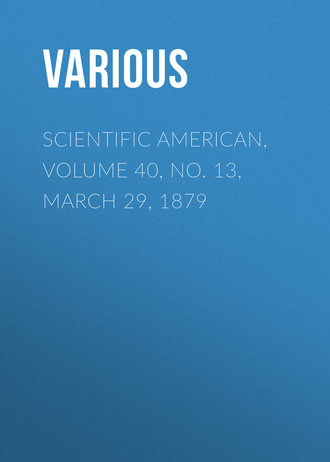 полная версия
полная версияScientific American, Volume 40, No. 13, March 29, 1879
Business and Personal
The Charge for Insertion under this head is One Dollar a line for each insertion; about eight words to a line. Advertisements must be received at publication office as early as Thursday morning to appear in next issue.
Valves and Hydrants, warranted to give perfect satisfaction. Chapman Valve Manuf. Co., Boston, Mass.
Brown & Sharpe, Prov., R. I. Best Gear Teeth Cutters and Index Plates at low prices. Send for catalogue.
Wanted—Galvanic Battery, Induction Coil, Electro-Magnet. Address, with description and price, Box 1700, Boston, Mass.
New Steam Governor.—Entire right for $3,000. For circulars address E. Towns, Cisne, Ill.
Gutta Percha, pure and sheeted, for sale in quantities to suit. Anderson & Reynolds, Salem, Mass.
The new fragrant Vanity Fair Cigarettes. New combinations of rare Old Perique and Virginia.
Wanted—Second-hand Corliss Engine, 100 to 125 H. P. Address P. O. Box 1208, New Haven, Conn.
17 and 20 in. Gibed Rest Screw Lathes. Geo. S. Lincoln, Hartford, Conn.
"Downer's Anti-Incrustation Liquid" for Removal and Prevention of Scales in Steam Boilers, is spoken of in highest terms by those who have given it a thorough trial. Circulars and price lists furnished on application. A. H. Downer, 17 Peck Slip, New York.
Mr. W. B. Adams, one of the most extensive contractors and decorators in this city, says he has used nearly fifty thousand gallons of H. W. Johns' Asbestos Liquid Paints, and after an experience of twenty years with white lead and other paints, he considers them not only superior in richness of color and durability, but owing to their wonderful covering properties, they are fully 20 per cent more economical than any others.
New Pamphlet of "Burnham's Standard Turbine Wheel" sent free by N. F. Burnham, York, Pa.
Gaume's Electric Engine. 171 Pearl St., B'klyn, N. Y.
Engines, ½ to 5 H. P. G. F. Shedd, Waltham, Mass.
Clipper Injector. J. D. Lynde, Philadelphia, Pa.
Diamond Drills, J. Dickinson, 64 Nassau St., N. Y.
Eagle Anvils, 9 cents per pound. Fully warranted.
Case Hardening Preparation. Box 73, Willimantic, Ct.
Vertical Burr Mill. C. K. Bullock, Phila., Pa.
Sheet Metal Presses, Ferracute Co., Bridgeton, N. J.
Mundy's Pat. Friction Hoist. Eng., of any power, double and single. Said by all to be the best. J. S. Mundy, Newark, N. J.
Auction Sale.—The Machinery and Property of the well known Hardie's Machine Works, 62 and 64 Church St., Albany, N. Y., will be sold March 26, at noon. No postponement.
To Manufacturers or Capitalists.—A rare chance to control a valuable agricultural patented implement. Address S. A. Fisher, Maplewood, Mass.
Reflecting Telescope, 6½ inches aperture, well mounted, price only $70. J. Ramsden, Philadelphia, Pa.
See Hogins' Laundry Table, illustrated on page 194. State, Canada, and entire right for sale.
Emery.—Best Turkey Emery in bbls., kegs, and cases in quantities to suit. Greene, Tweed & Co., 18 Park Place, N. Y.
The Scientific American Export Edition is published monthly, about the 15th of each month. Every number comprises most of the plates of the four preceding weekly numbers of the Scientific American, with other appropriate contents, business announcements, etc. It forms a large and splendid periodical of nearly one hundred quarto pages, each number illustrated with about one hundred engravings. It is a complete record of American progress in the arts.
Gold, Silver, and Nickel Plater wants situation. Address Plater, Oakville, Conn.
Amateur Photo. Apparatus, including instructions; outfits complete. E. Sackmann & Co., 278 Pearl St., N. Y.
Outfits for Nickel and Silver Plating, $5 to $200. Union Silver Plating Company, Princeton, Ill.
Send for Circulars of Indestructible Boot and Shoe Soles to H. C. Goodrich, 40 Hoyne Ave., Chicago, Ill.
For Sale.—Brown & Sharp Universal Milling Machine; Bement Profiling Machine; first-class 2d hand Machine Tools. E. P. Bullard, 14 Dey St., New York.
For Sale.—7 foot bed Putnam Planer, $350. A. A. Pool & Co., Newark, N. J.
Bevins & Co.'s Hydraulic Elevator. Great power, simplicity, safety, economy, durability. 94 Liberty St. N. Y.
A Cupola works best with forced blast from a Baker Blower. Wilbraham Bros., 2,318 Frankford Ave., Phila.
Shaw's Noise Quieting Nozzles and Mercury Pressure Gauges. T. Shaw, 915 Ridge Ave., Philadelphia, Pa.
For Solid Wrought Iron Beams, etc., see advertisement. Address Union Iron Mills, Pittsburgh, Pa., for lithograph, etc.
H. Prentiss & Company, 14 Dey St., N. Y., Manufs. Taps, Dies, Screw Plates, Reamers, etc. Send for list.
Presses, Dies, and Tools for working Sheet Metal, etc. Fruit & other can tools. Bliss & Williams, B'klyn, N. Y.
Nickel Plating.—A white deposit guaranteed by using our material. Condit, Hanson & Van Winkle, Newark, N. J.
Hydraulic Elevators for private houses, hotels, and public buildings. Burdon Iron Works, Brooklyn, N. Y.
The Lathes, Planers, Drills, and other Tools, new and second-hand, of the Wood & Light Machine Company, Worcester, are to be sold out very low by the George Place Machinery Agency, 121 Chambers St., New York.
Hydraulic Presses and Jacks, new and second hand. Lathes and Machinery for Polishing and Buffing Metals E. Lyon & Co., 470 Grand St., N. Y.
Solid Emery Vulcanite Wheels—The Solid Original Emery Wheel—other kinds imitations and inferior. Caution.—Our name is stamped in full on all our best Standard Belting, Packing, and Hose. Buy that only. The best is the cheapest. New York Belting and Packing Company, 37 and 38 Park Row, N. Y.
Pulverizing Mills for all hard substances and grinding purposes. Walker Bros. & Co., 23d & Wood St., Phila., Pa.
Portland Cement—Roman & Keene's, for walks, cisterns, foundations, stables, cellars, bridges, reservoirs, breweries, etc. Remit 25 cents postage stamps for Practical Treatise on Cements. S. L. Merchant & Co., 53 Broadway, New York.
Needle Pointed Iron, Brass, and Steel Wire for all purposes. W. Crabb, Newark, N. J.
Manufacturers of Improved Goods who desire to build up a lucrative foreign trade, will do well to insert a well displayed advertisement in the Scientific American Export Edition. This paper has a very large foreign circulation.
Band Saws, $100; Scroll Saws, $75; Planers, $150; Universal Wood Workers and Hand Planers, $150, and upwards. Bentel, Margedant & Co., Hamilton, Ohio.
The best Friction Clutch Pulley and Friction Hoisting Machinery in the world, to be seen with power applied, 95 and 97 Liberty St., New York. D. Frisbie & Co., New Haven, Conn.
C. M. Flint, Fitchburg, Mass., Mfr. of Saw Mills and Dogs, Shingle and Clapboard Machines. Circulars.
Blake's Belt Studs; strongest, cheapest, and best fastening for Leather or Rubber Belts. Greene, Tweed & Co., New York.
No gum! No grit! No acid! Anti-Corrosive Cylinder Oil is the best in the world, and the first and only oil that perfectly lubricates a railroad locomotive cylinder, doing it with half the quantity required of best lard or tallow, giving increased power and less wear to machinery, with entire freedom from gum, stain, or corrosion of any sort, and it is equally superior for all steam cylinders or heavy work where body or cooling qualities are indispensable. A fair trial insures its continued use. Address E. H. Kellogg, sole manufacturer, 17 Cedar St., New York.
The unprecedented demand for Kinney Bros.' New Cigarette, Sweet Caporal, is a good recommendation as to their merit.
Wheels and Pinions, heavy and light, remarkably strong and durable. Especially suited for sugar mills and similar work. Pittsburgh Steel Casting Company, Pittsburgh, Pa.
Deoxidized Bronze. Patent for machine and engine journals. Philadelphia Smelting Co., Phila., Pa.
For Sale.—4 H. P. Vertical Engine and Boiler (New York Safety Steam Power Co.'s make), as good, and in some respects better, than new. Address H. M. Quackenbush, Herkimer, N. Y.
Wood-working Machinery, Waymouth Lathes. Specialty, Wardwell Patent Saw Bench; it has no equal. Improved Patent Planers; Elevators; Dowel Machines. Rollstone Machine Company, Fitchburg, Mass.
Galland & Co.'s improved Hydraulic Elevators. Office 206 Broadway, N. Y., (Evening Post Building, room 22.)
The only economical and practical Gas Engine in the market is the new "Otto" Silent, built by Schleicher. Schumm & Co., Philadelphia, Pa. Send for circular.
Dead Pulleys that stop the running of loose pulleys and their belts, controlled from any point. Send for catalogue. Taper Sleeve Pulley Works, Erie, Pa.
Vick's Illustrated Monthly Magazine is one of the most beautiful magazines in the world. Each number contains a chromo of some group of flowers, and many fine engravings. Published monthly at $1.25 per year. Address James Vick, Rochester, N. Y.

No attention will be paid to communications unless accompanied with the full name and address of the writer.
Names and addresses of correspondents will not be given to inquirers.
We renew our request that correspondents, in referring to former answers or articles, will be kind enough to name the date of the paper and the page, or the number of the question.
Correspondents whose inquiries do not appear after a reasonable time should repeat them.
Persons desiring special information which is purely of a personal character, and not of general interest, should remit from $1 to $5, according to the subject, as we cannot be expected to spend time and labor to obtain such information without remuneration.
(1) S. Q.—The speed of a circular saw at the periphery should be from 6,000 to 7,000 feet per minute. The number of revolutions per minute will of course vary with the diameter of the saw.
(2) T. J. F. asks (1) for the best way to fasten emery on a wooden wheel, to be used in place of a solid emery wheel. A. Cover the wheel with leather devoid of grease, and coat the leather surface, a portion at a time, with good glue; immediately roll the glued surface in emery spread out on a board. 2. How can I fasten small pieces of looking glass on iron? A. Use equal parts of pitch and gutta percha mixed together.
(3) W. C. asks: 1. What is the power of the simple electric light described in Supplement No. 149? A. When supplied with a strong current it is equal to 5 or 6 5-foot gas burners. It is designed for temporary use only. 2. What is the cost of manufacturing the dynamo-electric machine in Supplement No. 161? A. The one shown in the article referred to cost about $35.
(4) L. D. asks: 1. Which is the better conductor, silver or copper? A. Silver. 2. And the comparative resistance offered to the electric current by water and the above? A. Taking pure silver as 100,000,000, the conductivity of distilled water would be 0.01.
(5) H. J. F. writes: In Supplement 162 a simple electric light is described. I wish to light a room 20x20x10 feet. 1. How large is the bell glass? A. 2½ inches. 2. Can I use battery carbon? A. Use a carbon pencil made for electric lamps. 3. How can I make tray water tight after putting wire through? A. With gutta percha. 4. I have one large cell Bunsen and one Smee. How many more and of what kind shall I get? A. One of the batteries described in Supplements 157, 158, 159, will do, probably 8 or 10 Bunsen elements would be the best.
(6) W. B. F. writes: I tried to make an electric pen, like the one described in your Scientific American, of February 22d, 1879, using a Smee's battery, a circuit breaker, and an induction coil, but it did not work. Is there anything wrong, or is a condenser different from an induction coil? A. A condenser consists of a number of sheets of tin foil separated from each other by larger sheets of paper. One half of the tin foil sheets are connected with one terminal of the primary coil, the other half with the other terminal; the tin foil sheets connected with one terminal alternate with those of the other terminal. The condenser is essential to the working of the coil. For complete directions for making induction coils, see Scientific American Supplement No. 160.
(7) J. De F. asks: 1. Knowing the resistance of a wire of given conductivity, length, and diameter, will the resistance of any other wire be in proportion inversely? A. Yes. 2. Is there heat enough developed in the secondary coil of an induction coil to prevent the use of paraffine as an insulating material? A. With proper battery power, no. 3. How high in the list of non-conductors does paraffine stand? A. It is one of the best. 4. Will a cotton insulator soaked in paraffine answer as well as silk? A. No, because it renders the covering of the wire too thick. 5. Can you recommend any insulating material for making induction coils which will dry rapidly? A. Alcoholic shellac varnish. Rosin to which a little beeswax has been added is an excellent insulator; it must be applied in a melted state. 6. What is the composition of the black material covering the Leclanche porous cell? A. Gutta percha. 7. Is the magneto-electric machine described in the Scientific American Supplement patented? A. To which do you refer? Most, if not all of them are patented.
(8) B. V. F. writes: With reference to item 8, on page 139, of Scientific American, March 1, 1879, I think there is some mistake about the coal you think required to heat 1,000 cubic feet space. I burn some 8 tons coal to heat, in the whole year, such part of my house as must exceed 25x20x18=9,000 cubic feet. We keep up a moderate heat at night. Ventilate more than most families do; take part only of the cool air, and only in part of the coldest weather, from the cellar, which at such times is opened into the main entries. House wood, back plastered, and stands alone. If 100 lbs. coal would heat 1,000 feet one day, I ought to burn 900 lbs. a day, or nearly 14 tons in December and 14 more in January. A. We are glad to receive these data, which correspond quite closely with some obtained by recent accurate experiments. The estimate given in the Scientific American also agrees well with experiments on the use of hot air heaters for very small buildings or rooms. Of course, the larger the space to be heated, the more economically it can generally be done.
(9) W. M. S. asks: Will the coil described in Supplement No. 160 do for the electric pen described in a recent number of the Scientific American? If not how must it be changed? A. It is too large; make it one half the size given.
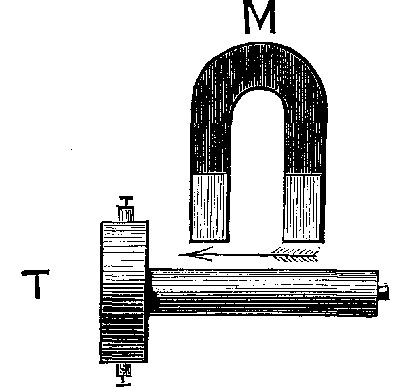
(10) B. G.—In reply to your inquiry as to Mr. Stroh's telephone experiment, we give the following, which we clip from the English Mechanic: A singular experimental effect, of special interest just now from its possible bearing on the theory of the source of sound in the Bell telephone, has just been observed by Mr. Stroh, the well known mechanician. If a telephone, T, with the circuit of its coil left open, be held to the ear, and a powerful magnet, M, be moved gently up and down along the length of the magnet, as shown by the arrow, and at a distance of an inch or two from it, a faint breathing sound will be heard, the recurring pulses of sound keeping time with the up and down motion of the magnet. The sound may be aptly compared to the steady breathing of a child, and there is a striking resemblance between it and the microphonic sounds of gases diffusing through a porous septum as heard by Mr. Chandler Roberts. We understand that Professor Hughes is investigating the cause of this curious sound by help of the microphone.
(11) "Enterprise" asks: What part of its volume will iron expand in passing from a temperature of 60° to melting temperature? A. The cubical expansion of iron for each degree (C.) between 0° and 100° is 0.00003546 of its volume, its volume being 1. This ratio however, increases somewhat at higher temperatures, since the mean coefficient of expansion for each degree between 0° C. and 300° C. is 0.00004405. The question you ask has probably never been settled. You may form an approximation by the use of the above ratios, knowing the melting point of the iron.
(12) P. L. O. asks for a good chemistry for a beginner to study without a teacher. A. Fownes' "Chemistry;" Gorup-Besanez, "Inorganic, Organic and Physiological Chemistry."
(13) L. E. M. asks: What is the best method of keeping fine guns from rusting, and what oil should be used? A. For the outside, clear gum copal 1 part, oil of rosemary 1 part, absolute alcohol 3 parts. Clean and heat the metal and apply a flowing coat of the liquid by means of a camel's hair brush. Do not handle until the coat becomes dry and hard. For the inside of the barrel a trace of refined sperm oil is as good as anything, but an excess should be avoided.
(14) A. H. B. asks how much weight, falling 10 feet, will be required to produce one horse power for five hours? A. One horse power for 5 hours = 33,000 × 300 = 9,900,000 foot pounds—so that the weight required is 9,900,000 ÷ 10 = 990,000 lbs.
(15) A. D. R. asks: 1. In renewing a Leclanche battery, do the zincs have to be amalgamated? A. They are usually amalgamated. 2. Will two cells large size Leclanche battery give any light, using the simple lamp described in Supplement No. 162? A. No.
(16) H. L. J. writes: In a recent issue of the Scientific American you state that the floating of solid iron on melted iron is on the same principle as the floating of ice in water. I do not quite understand how it can be. Please explain. A. Solid iron, at an elevated temperature, floats upon molten iron for the same reason that ice floats upon molten ice-water—because it is specifically lighter. You will find the subject discussed at length in Tyndall's "Heat as a Mode of Motion."
(17) J. W. will find full directions for canning corn, etc., on p. 394 (4), vol. 39, Scientific American.
(18) "Amateur" writes: I wish to make some small bells that have a clear ring. What metal or metals can I use that I can melt easily? A. Use an alloy of tin and antimony. See Scientific American Supplement No. 17.
(19) H.—A nutritious mixed diet is unquestionably the best, care being taken to avoid an excess of meat.
(20) W. F. writes: I have made an engine, and would like to find out what size of boiler it will require. The cylinder has 2¼ inch bore and 3 inches stroke. A. It depends upon pressure and speed to be maintained; probably a vertical tubular boiler, 15 inches diameter, and 32 to 36 inches high, would suit you.
(21) R. G. (Salt Lake).—Please send full name.
(22) J. M. G. asks: If two persons each pull one hundred pounds on opposite ends of a rope, what will be the strain on the rope? A. The strain on the rope will be 100 lbs.
(23) W. M. M. asks: In laying off a mill stone in furrows, what draught is given? What amount of the space of a stone is given to furrows and what to grinding surface? A. There is considerable difference in the practice of various millers, and we would be glad to receive communications from those experienced in the art of dressing millstones.
Minerals, Etc.—Specimens have been received from the following correspondents, and examined, with the results stated:
S. (New Orleans.)—The powder consists of a mixture of zinc oxide and finely powdered resin. A quantitative analysis would be necessary to determine the proportions.
Any numbers of the Scientific American Supplement referred to in these columns may be had at this office. Price 10 cents each.
COMMUNICATIONS RECEIVED.Life Preserving Stone. By J. D. W.
On Ventilation. By D. W.
What is Mental Action? By N. K.
Panama Railroad or Canal. By G. R. P.
A Problem. By K.
On the Gary Motor. By G. F. M.
Magnetic Motor. By G. W. W., W. A. A., G. H. F.
House Warming. By H. B. F.
The Injector. By M. A. B.
Columbus' Problem; Cure for Diphtheria; The Mullein
Cure for Consumption. By R. W. L.
A Visit to Tula. By L. R.
On Vacuum in Pumps and the Atwood Machine. By P. J. D.
On the Patent Bill. By R.
[OFFICIAL.]INDEX OF INVENTIONSFOR WHICHLetters Patent of the United States were Granted in the Week EndingFebruary 18, 1879,AND EACH BEARING THAT DATE[Those marked (r) are reissued patents.]A complete copy of any patent in the annexed list, including both the specifications and drawings, will be furnished from this office for one dollar. In ordering, please state the number and date of the patent desired, and remit to Munn & Co., 37 Park Row, New York city.
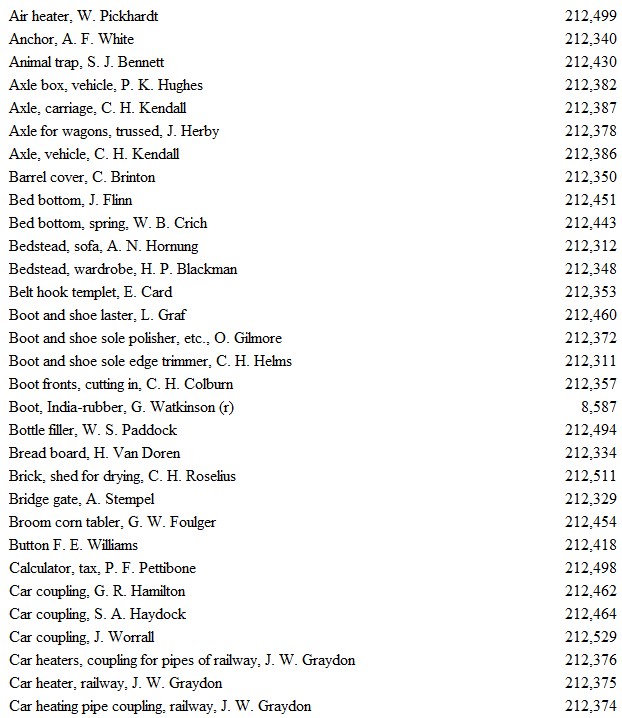



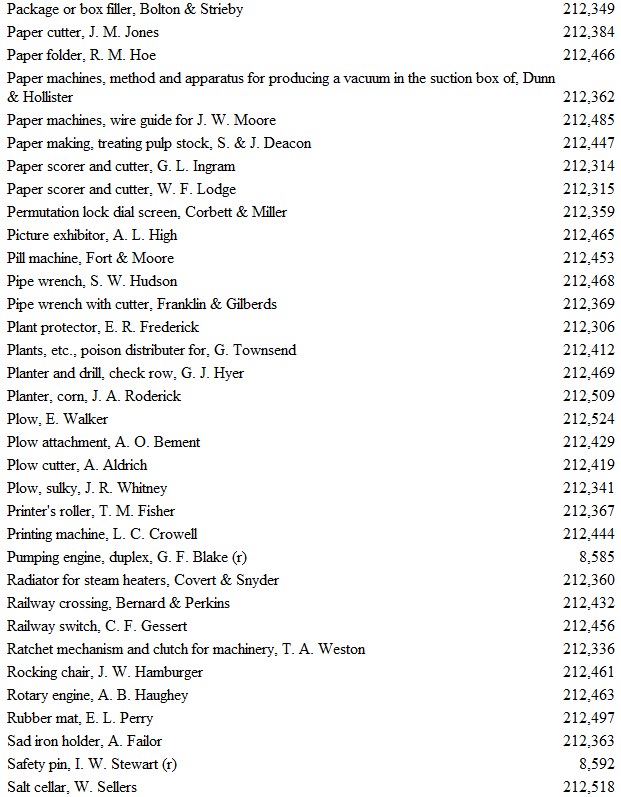
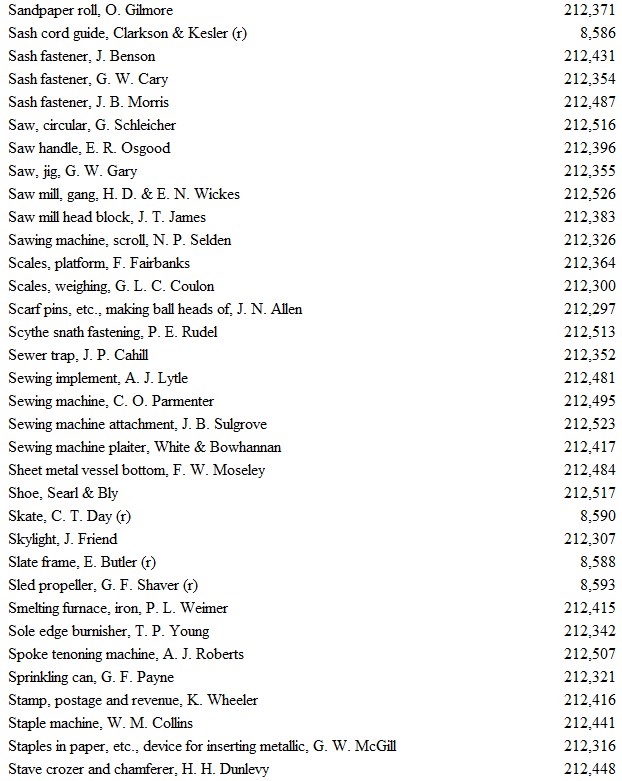
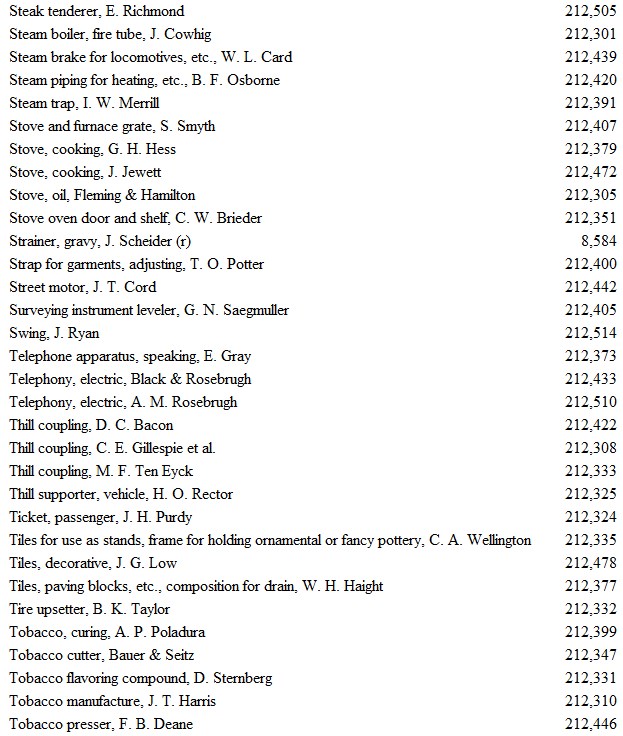

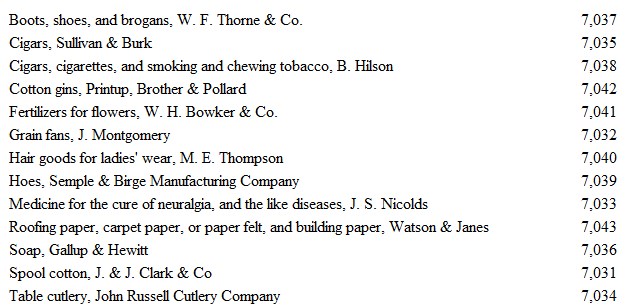

Bed bottoms, etc.—C. D. Flynt, Brooklyn, N. Y.
Berth.—D. Huston, Boston, Mass.
Lead smelting furnace.—G. T. Lewis, Philadelphia, Pa.
Locks.—A. P. Thomas et al., Baltimore, Md.
Railway joint.—P. T. Madison, Indianapolis, Ind.
Spikes for railroads.—R. Bocklen, New York city.
Ventilating buildings.—F. S. Norton, New York city.
AdvertisementsInside Page, each insertion 75 cents a line.
Back Page, each insertion $1.00 a line.
(About eight words to a line.)Engravings may head advertisements at the same rate per line, by measurement, as the letter press. Advertisements must be received at publication office as early as Thursday morning to appear in next issue.
A Rare Opportunity, on Easy TermsTo be sold at Auction, at Charleston, South Carolina, on Tuesday, the first day of April, 1879, the Taylor Iron Works, complete and in operation, together with all stores, stock, and work on hand on day of sale.
The above is a large, first-class engineering establishment, complete within itself for all kinds of work, comprising iron and brass foundries, boiler shop, machine shops, pattern and millwright shops, with a large stock of patterns for local machinery, and Taylor presses. Connected with the works is a large, well-stocked engineer and mill supply store. All departments have the best of modern tools in thorough repair. Buildings comparatively new, and conveniently arranged on large grounds. The business was established 1844; has always done a large business and maintained a high reputation. The present works, built since 1866, have ample facilities to work 200 men. At present about 100 men are employed. For further particulars apply to the works or to JOHN F. TAYLOR, Sharon Springs, N. Y., who will meet parties at Albany, N. Y., by appointment, or New York, if preferred.
LARGEST ASSORTMENT IN THE WORLDof Plays, Dramas, Comedies, Farces, Ethiopian Dramas, Plays for Ladies only, Plays for Gentlemen only. Wigs, Beards, Moustaches, Face Preparations, Burnt Cork, Jarley's Wax Works, Tableaux, Charades, Pantomimes, Guides to the Stage, and for Amateurs Make up Book, Make up Boxes, New Plays. SAM'L FRENCH & SON, 38 East 14th St., Union Square, New York.









